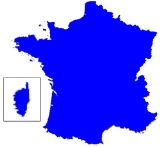
French National Police
Overview
Sûreté
Sûreté is a term used in French speaking countries or regions in the organizational title of a civil police force, especially the detective branch thereof.-France:...
, is one of two national police
Police
The police is a personification of the state designated to put in practice the enforced law, protect property and reduce civil disorder in civilian matters. Their powers include the legitimized use of force...
forces and the main civil law enforcement agency of France
France
The French Republic , The French Republic , The French Republic , (commonly known as France , is a unitary semi-presidential republic in Western Europe with several overseas territories and islands located on other continents and in the Indian, Pacific, and Atlantic oceans. Metropolitan France...
, with primary jurisdiction in cities and large towns. The other main agency is the military Gendarmerie, with primary jurisdiction in smaller towns and rural and border areas. The National Police comes under the jurisdiction of the Ministry of the Interior
Minister of the Interior (France)
The Minister of the Interior in France is one of the most important governmental cabinet positions, responsible for the following:* The general interior security of the country, with respect to criminal acts or natural catastrophes...
and has about 145,699 employees (in April 2008).
The National Police operate mostly in large cities and towns.
Discussions

